Technical Highlight of
911
The long-live 901 engine
From
2.0 to 3.8: the power of Nikasil
It is hard
to believe an engine could be enlarged so much without even altering the
distance between bore centres. The biggest difficulty faced by engineers
was how to squeeze more capacity out of the unchanged dimensions. According
to the original calculation - although Porsche had already built in considerable
potential for development into the original design - it was expected to
be stretched to maximum 2.7 litres only. Anything larger than 2.7 litres
required a bore so large that the cylinder wall would have become too thin
to be reliable. As the 911 was designed with endurance GT racing very much
in mind, and admitted, strong reliability was always one of the core valves
of Porscheís philosophy, it seemed that the Type 901 engine would have
never grown to more than 2.7 litres.
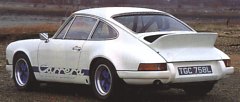 However,
a breakthrough was made in the í73 Carrera RS 2.7. It introduced Nikasil
technology to get rid of the original Biral cylinder, hence allowing the
bore to be grown from the original 2.0-litre unitís 80 mm to as much as
95 mm while still had a sufficiently thick cylinder wall. To understand
that, we must have a little bit explanation to the original cylinder design.
However,
a breakthrough was made in the í73 Carrera RS 2.7. It introduced Nikasil
technology to get rid of the original Biral cylinder, hence allowing the
bore to be grown from the original 2.0-litre unitís 80 mm to as much as
95 mm while still had a sufficiently thick cylinder wall. To understand
that, we must have a little bit explanation to the original cylinder design.
Since the first 911, it used
so-called "Biral" cylinders, which is basically a cast iron cylinder liner
with aluminium air-cooling fins casting around. Why not all-aluminium?
because the pistons were also cast aluminium. It is commonly known that
the contact between two aluminium surfaces always result in higher friction
and wear than the contact between aluminium and iron. Therefore an all-aluminium
engine without special treatment is always infeasible. Biral cylinders
were employed to solve this problem.
As the Biral cylinder has
two layers of different materials made in casting, the cylinder wall is
inherently thicker than a pure aluminium cylinder yet doesnít provide superior
mechanical strength. Instead of cast iron liner, Nikasil treatment coats
a layer of Nickel-silicon carbide, usually by electrolytic deposition,
to the inner surface of aluminium cylinders. Since Nikasil layer generates
even less friction than cast iron liner, revability and power are both
enhanced. Moreover, it is only a few hundreds of a millimetre thick, therefore
the bore can be enlarged significantly. Porsche had already tried this
technology in the 917 racing car successfully before applying to the 911
RS 2.7.
This was only the beginning.
In fact, the Nikasil gave the engine a second phase of life, enabling the
bore to be increased to 102 mm (thus displaced 3746 c.c.) eventually. Of
course, the stroke was also increased from the 2.7 RSís 70.4 mm to the
3.8 RSís 76.4 mm, thus involving some revisions to crankshaft and con-rods.
The magnesium crankcase used since the 2.2-litre had to be changed back
to the heavier aluminium one for the advantage of strength.
The production 2.7-litre
unit once discarded the Nikasil treatment and in favour of a cheaper arrangement
- pure aluminium cylinders matched with iron-coated aluminium pistons,
which was just a reversal pair of the original Biral cylinder / aluminium
piston. However, as Nikasil had superior power advantage, it was adopted
again since the 3-litre engine appeared.
Pioneering
Turbocharging
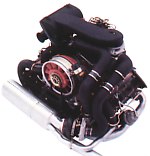 Although
turbocharing had been appeared in Chevrolet Corvair and BMW 2002 turbo
in the late 60s, Porsche 911 Turbo was unquestionably the first to cure
the turbo lag problem and made turbocharging practical for road use.
Although
turbocharing had been appeared in Chevrolet Corvair and BMW 2002 turbo
in the late 60s, Porsche 911 Turbo was unquestionably the first to cure
the turbo lag problem and made turbocharging practical for road use.
The advantage of turbocharging
is obvious - instead of wasting thermal energy through exhaust, we can
make use of such energy to increase engine power. By directing exhaust
gas to rotate a turbine, which drives another turbine to pump air into
the combustion chambers at a pressure higher than normal atmosphere, a
small capacity engine can deliver power comparable with much bigger opponents.
As a result, engine size and weight can be much reduced, thus leads to
better acceleration, handling and braking, though fuel consumption is not
necessarily better.
Problems
However, no matter the Corvair
or the 2002, they failed to make turbocharging practical for road use.
The main obstacle was turbo lag. Before low inertia turbine appeared, turbines
were very heavy, thus could not start spinning until about 3,500 rpm crank
speed. As a result, low-speed output remained weak. Besides, since the
contemporary turbocharging required compression ratio to be decreased to
about 6.5:1 in order to avoid overheat to cylinder head, the pre-charged
output would be even weaker than a normally-aspirated engine of the same
capacity !
Turbo lag can cause trouble
in daily driving. Before the turbo intervenes, the car performs like an
ordinary sedan. Open full throttle and raise the engine speed, suddenly
the power surge at 3,500 rpm and the car becomes a wild beast. On wet surfaces
or tight bends this might result in wheel spin or even lost of control.
Besides, turbo lag ruins
the refinement of a car very much. Floor the throttle cannot result in
instant power rise expected by the driver - all reaction will appear several
seconds later, no matter acceleration or releasing throttle. You can imagine
how difficult to drive fast in city or twisted roads.
Porsche's
Breakthrough
Like BMW, Porsche started developing
turbo for the purpose of motor racing. In the early 70s, in order to fight
with the 8-litre Chevy in Can-Am, Porsche created the mighty 1000 hp turbocharged,
flat-12 engined 917 racer, which soon dominated the whole world. Successful
experience led to the application of turbocharging to 911 Carrera RSR Turbo
GT racer, which finished 2nd in LeMans. So far, Porsche made turbocharging
became the dominating force in GT racing.
Next step was to transform
turbocharging for road use. As we have learned, turbo lag was the biggest
difficulty preventing turbocharging technology from being practical. To
solve this, Porsche's engineers designed a mechanism allowing the turbine
to "pre-spin" before boosting. The secret was a recirculating pipe and
valve: before the exhaust gas attains enough pressure for driving the turbine,
a recirculating path is established between the fresh-air-charging turbine's
inlet and outlet, thus the turbine can spin freely without slow down by
boost pressure. When the exhaust gas becomes sufficient to turbocharge,
a valve will close the recirculating path, then the already-spinning turbine
will be able to charge fresh air into the engine quickly. Therefore turbo
lag is greatly reduced while power transition becomes smoother.
Turbo
3.0
This technology was first introduced
to the Turbo 3.0 of 1975. The Type 930/50 engine was derived from the RS
3.0, with compression ratio reduced to 6.5:1 rather than 8.5:1, a KKK turbocharger
generated boost pressure up to 0.8 bar (governed by a mechanical waste
gate). Like the RS, it employed forged pistons, but the fuel supply was
changed to cleaner (if less powerful) Bosch K-Jetronic mechanical injection
while electronic ignition was first introduced. Power and torque jumped
to 260 hp at 5500 rpm and 254 lbft at 4000 rpm respectively, compare with
the RS's 230 hp at 6200rpm and 203 lbft at 5000 rpm. The turbo engine was
lazier to rev but performed a lot stronger since middle rev, hence providing
superior performance in an effortless way.
Introduction
of intercooler
 The
3.3-litre version of the turbocharged engine, Type 930/66, superseded the
Turbo 3.0 in 1978. It raised output to 300 hp and 303 lbft. The increased
power thanks to the use of intercooler between the compressor and the engine,
which was located under the rear spoiler. It reduced the air temperature
for 50-60°C, thus not only improved the volumetric efficiency (in other
words, the intake air became of higher density) but also allowed the compression
ratio to be raised to 7.0:1.
The
3.3-litre version of the turbocharged engine, Type 930/66, superseded the
Turbo 3.0 in 1978. It raised output to 300 hp and 303 lbft. The increased
power thanks to the use of intercooler between the compressor and the engine,
which was located under the rear spoiler. It reduced the air temperature
for 50-60°C, thus not only improved the volumetric efficiency (in other
words, the intake air became of higher density) but also allowed the compression
ratio to be raised to 7.0:1.
In 1983, the 3.3 Turbo was
upgraded to Type 930/66, which employed a more sophisticated KE-Jectronic
electronic injection and improved ignition. The result was increased torque
to 318 lbft although peak power remained unchanged.
The introduction of turbocharger
lifted the 911 into the league of supercars. Between 1978 and 85, the 3.3
Turbo was the fastest accelerating production car in the world, beating
all expensive opponents from Ferrari and Lamborghini.
The
M64 series: pushing to the limit
When the
M64/01 engine appeared in the 964 Carrera 4 in 1989, its origin was already
25 years old. The distance between bore centres was never changed, but
Porsche managed to increase the bore to 100 mm and the stroke to 76.4 mm
(once again employed Nikasil treatment). That resulted in a displacement
of exactly 3600 c.c.. Power and torque increased from 231 hp / 210 lbft
to 250 hp / 228 lbft, even though now the catalytic converter was standard
and emission regulations had been tightened.
 Apart
from the increase of capacity, most power came from the higher compression
ratio, which was 11.3:1 compared with the previous 10.3:1. This was made
possible by the introduction of twin-spark per cylinder and knock sensor.
The former alone contributed to 10 hp and 3% reduction in consumption,
thanks to more efficient burning. The latter was attached to each bank
of cylinder and detected the shock wave resulting from knock. From the
crankshaft angle, the advanced Motronic engine management system calculated
in which cylinder the knock took place, and then retarded ignition in that
cylinder. Therefore, the increase of compression was achieved without requiring
higher Octane fuel.
Apart
from the increase of capacity, most power came from the higher compression
ratio, which was 11.3:1 compared with the previous 10.3:1. This was made
possible by the introduction of twin-spark per cylinder and knock sensor.
The former alone contributed to 10 hp and 3% reduction in consumption,
thanks to more efficient burning. The latter was attached to each bank
of cylinder and detected the shock wave resulting from knock. From the
crankshaft angle, the advanced Motronic engine management system calculated
in which cylinder the knock took place, and then retarded ignition in that
cylinder. Therefore, the increase of compression was achieved without requiring
higher Octane fuel.
The M64/01 engine also introduced
a new "resonance" variable intake system which boost mid to high rev efficiency.
Each bank of cylinders was fed by a common plenum chambers through separate
pipes. The two plenum chambers were interconnected by two pipes of different
diameters. One of the pipes can be closed by a valve controlled by engine
management system. The firing order was arranged such that the cylinders
breathed alternately from each chamber, creating pressure wave between
them. If the frequency of pressure wave matched the rev, it could help
filling the cylinders, thus improved breathing efficiency. As the frequency
depended on the cross-sectional area of the interconnecting pipes, by closing
one of them at below 5,400 rpm, the area as well as frequency reduced,
thus enhanced mid-rev output. At above 5,500 rpm, the valve opened and
increased high-speed efficiency.
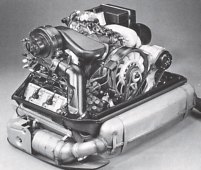 |
Other changes included:
-
2.2 kg lighter crankshaft;
-
Plastic intake manifold;
-
increase valve overlapping,
higher lift;
-
quieter, all-new timing chain
tensioners;
-
drilled and sodium-filled intake
valves, which were lighter and increase rev by 200 rpm;
-
ceramic exhaust port liners,
which reduce head temperature by 40°C and made sodium-cooled exhaust
valves unnecessary.
|
M64/05
engine for 993
Modified from the M64/01 engine,
with the following changes:
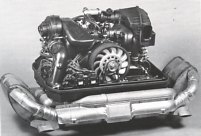 |
-
Lightened con-rods from 632
g to 520 g per piece;
-
Lightened pistons from 657 g
to 602 g per piece;
-
10 g lighter valves;
-
Redesigned cam box;
-
Enlarged intake port;
-
Freer exhaust system by means
of larger silencer and catalyst;
-
98 RON fuel instead of 95 RON;
-
Reinforced crankshaft thus made
vibration damper unnecessary;
|
Overall speaking, the engine
was 6 kg lighter than the predecessor and rev higher, thus generated more
horsepower and torque - 272 hp and 243 lbft.
M64/21
engine with Varioram
The 993 engine was updated in
1995, mainly with the introduction of Varioram. It was a 3-stage variable
intake system based on the existing 2-stage resonance intake. The space-engaging
system can be seen easily above the engine (see picture).
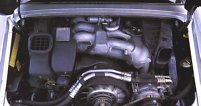 The
system added six long pipes for low-speed breathing, as longer intake manifolds
always lead to lower frequency of air mass thus serve better for low rev
cylinder filling. Below 5,000 rpm, only the long intake manifolds were
used for breathing, thus resulted in higher torque at such rev. Between
5,000 and 5,800 rpm, the original resonance intake system with short pipes
also intervened, but one of the interconnected pipes was closed so to provide
better mid-range output. At above 5,800 rpm, both interconnected pipes
of the resonance system were opened thus resulted in higher resonance frequency,
and of course better filling at such rev.
The
system added six long pipes for low-speed breathing, as longer intake manifolds
always lead to lower frequency of air mass thus serve better for low rev
cylinder filling. Below 5,000 rpm, only the long intake manifolds were
used for breathing, thus resulted in higher torque at such rev. Between
5,000 and 5,800 rpm, the original resonance intake system with short pipes
also intervened, but one of the interconnected pipes was closed so to provide
better mid-range output. At above 5,800 rpm, both interconnected pipes
of the resonance system were opened thus resulted in higher resonance frequency,
and of course better filling at such rev.
Besides, the M64/21 engine
also employed slightly larger valves. The output was raised to 285 hp and
251 lbft.
|
Illustration
to Varioram
|
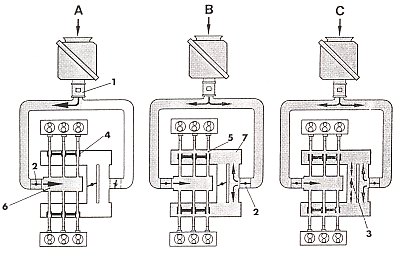
|
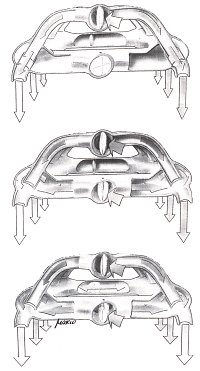
|
| Below 5,000
rpm (left A and top right) : long pipes; resonance intake disabled.
5,000-5,800 rpm (left B and
middle right) : long pipes plus short-pipe resonance intake, with one of
the interconnected pipes of the resonance intake closed.
Above 5,800 rpm (left C and
bottom right): long pipes plus short-pipe resonance intake, with both interconnected
pipes of the resonance intake opened. |
M64/60
- welcome twin-turbo
Ignoring minor revisions, the
last new engine for the 911 was the M64/60 twin-turbo engine used in the
911 Turbo of 1994. This is not the first turbo based on the 3.6-litre M64
engine - it was the 3.6 single turbo which served the 964 Turbo of 1993.
However, unlike its predecessor, it was an advanced design (if not ground-breaking)
rather than a stop-gap design, employing a sophisticated engine management
system including electronic boost control. In other words, the waste gate
was governed by computer, allowing different max. boost pressure for different
rev. For instance, a maximum 0.94 bar was available for 3,500 rpm, 0.6
bar for 5,200 rpm and 0.75 bar for 6,500 rpm. This made the engine extremely
responsive and linear.
The advanced engine management
enabled a rather high 8.0:1 compression ratio to be realised. Unlike Porsche
959, the twin-turbo of the 911 was arranged operated in parallel rather
than sequentially. More accurately speaking, each turbocharger was driven
by exhaust gas from one bank of cylinders, with individual waste gate.
The pressurised fresh air from the two turbines combined together and served
all six cylinders. Due to the advanced boost control and 750 c.c. more
displacement, the 911 engine actually felt more responsive and linear than
the sequential-turbo 959. In torque, the 911 also beat the 7 years older
959: 398 lbft of torque versus 369 lbft, no wonder 4-wheel-drive was compulsory
in this Turbo. Ultimate power, however, was less impressive. It was not
until the final form, Turbo S, that the 911 can level the 959ís 450 hp
output.
To cope with the new found
output, the twin-turbo got reinforced con-rods and hollow valves cooled
by natrium. Like the 3.6 single-turbo, it had single-spark instead of the
naturally aspirated engineís twin-spark for simplicity.
Copyright© 1997-2000
by Mark Wan
Return to AutoZine home page
 However,
a breakthrough was made in the í73 Carrera RS 2.7. It introduced Nikasil
technology to get rid of the original Biral cylinder, hence allowing the
bore to be grown from the original 2.0-litre unitís 80 mm to as much as
95 mm while still had a sufficiently thick cylinder wall. To understand
that, we must have a little bit explanation to the original cylinder design.
However,
a breakthrough was made in the í73 Carrera RS 2.7. It introduced Nikasil
technology to get rid of the original Biral cylinder, hence allowing the
bore to be grown from the original 2.0-litre unitís 80 mm to as much as
95 mm while still had a sufficiently thick cylinder wall. To understand
that, we must have a little bit explanation to the original cylinder design.
 Although
turbocharing had been appeared in Chevrolet Corvair and BMW 2002 turbo
in the late 60s, Porsche 911 Turbo was unquestionably the first to cure
the turbo lag problem and made turbocharging practical for road use.
Although
turbocharing had been appeared in Chevrolet Corvair and BMW 2002 turbo
in the late 60s, Porsche 911 Turbo was unquestionably the first to cure
the turbo lag problem and made turbocharging practical for road use.
 The
3.3-litre version of the turbocharged engine, Type 930/66, superseded the
Turbo 3.0 in 1978. It raised output to 300 hp and 303 lbft. The increased
power thanks to the use of intercooler between the compressor and the engine,
which was located under the rear spoiler. It reduced the air temperature
for 50-60°C, thus not only improved the volumetric efficiency (in other
words, the intake air became of higher density) but also allowed the compression
ratio to be raised to 7.0:1.
The
3.3-litre version of the turbocharged engine, Type 930/66, superseded the
Turbo 3.0 in 1978. It raised output to 300 hp and 303 lbft. The increased
power thanks to the use of intercooler between the compressor and the engine,
which was located under the rear spoiler. It reduced the air temperature
for 50-60°C, thus not only improved the volumetric efficiency (in other
words, the intake air became of higher density) but also allowed the compression
ratio to be raised to 7.0:1.
 Apart
from the increase of capacity, most power came from the higher compression
ratio, which was 11.3:1 compared with the previous 10.3:1. This was made
possible by the introduction of twin-spark per cylinder and knock sensor.
The former alone contributed to 10 hp and 3% reduction in consumption,
thanks to more efficient burning. The latter was attached to each bank
of cylinder and detected the shock wave resulting from knock. From the
crankshaft angle, the advanced Motronic engine management system calculated
in which cylinder the knock took place, and then retarded ignition in that
cylinder. Therefore, the increase of compression was achieved without requiring
higher Octane fuel.
Apart
from the increase of capacity, most power came from the higher compression
ratio, which was 11.3:1 compared with the previous 10.3:1. This was made
possible by the introduction of twin-spark per cylinder and knock sensor.
The former alone contributed to 10 hp and 3% reduction in consumption,
thanks to more efficient burning. The latter was attached to each bank
of cylinder and detected the shock wave resulting from knock. From the
crankshaft angle, the advanced Motronic engine management system calculated
in which cylinder the knock took place, and then retarded ignition in that
cylinder. Therefore, the increase of compression was achieved without requiring
higher Octane fuel.


 The
system added six long pipes for low-speed breathing, as longer intake manifolds
always lead to lower frequency of air mass thus serve better for low rev
cylinder filling. Below 5,000 rpm, only the long intake manifolds were
used for breathing, thus resulted in higher torque at such rev. Between
5,000 and 5,800 rpm, the original resonance intake system with short pipes
also intervened, but one of the interconnected pipes was closed so to provide
better mid-range output. At above 5,800 rpm, both interconnected pipes
of the resonance system were opened thus resulted in higher resonance frequency,
and of course better filling at such rev.
The
system added six long pipes for low-speed breathing, as longer intake manifolds
always lead to lower frequency of air mass thus serve better for low rev
cylinder filling. Below 5,000 rpm, only the long intake manifolds were
used for breathing, thus resulted in higher torque at such rev. Between
5,000 and 5,800 rpm, the original resonance intake system with short pipes
also intervened, but one of the interconnected pipes was closed so to provide
better mid-range output. At above 5,800 rpm, both interconnected pipes
of the resonance system were opened thus resulted in higher resonance frequency,
and of course better filling at such rev.

